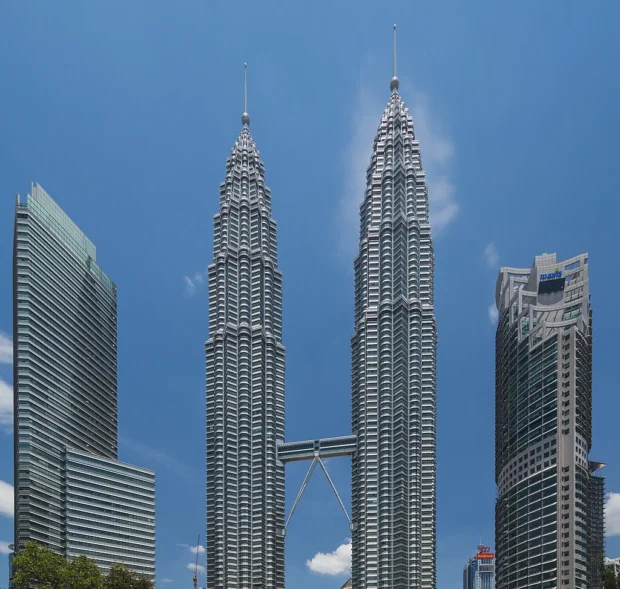Standing tall as the iconic symbol of Kuala Lumpur, Malaysia, the Petronas Towers dominate the cityscape with their sleek twin spires piercing the sky. These twin skyscrapers draw visitors worldwide who are eager to capture their architectural glory, explore their bustling surroundings, and immerse in Malaysia’s modern urban spirit. Whether you arrive from the Kuala Lumpur International Airport or the central transit stations, the Towers offer a journey into a striking blend of heritage and futuristic design. This guide shares insights on how to reach the Towers, best visiting times, rich stories behind their creation, and practical tips for making the most of your visit.
Table of Contents
After admiring the Petronas Towers, you might enjoy exploring other vibrant landmarks and flavors of Kuala Lumpur to broaden your visit.
Accessing the Petronas Towers With Ease
Located in the heart of Kuala Lumpur’s Golden Triangle, the Petronas Towers are well-connected by various transport options, ensuring a smooth arrival for travelers.
From the City Center and Transit Hubs
The most straightforward way to reach the Towers from Kuala Lumpur’s city center or other popular areas is via the Kelana Jaya Line of the Light Rail Transit (LRT). Alight at the KLCC Station, which is directly connected to the towers’ base through an underground pedestrian tunnel. This connection is seamless and helps you avoid the busy street traffic.
If you come from the Kuala Lumpur International Airport, the Airport Rail Link offers a direct service to KL Sentral, where you can transfer to the Kelana Jaya LRT line heading towards KLCC. The entire trip offers a glimpse of the city’s urban layout, with striking high-rises gradually coming into view.
By Taxi or Ride-Hailing Services
Taxis and ride-hailing options such as Grab are popular and convenient, especially if you are visiting with luggage or prefer a door-to-door experience. The Tower’s main entrance welcomes vehicles, dropping passengers close to the iconic fountain plazas and spacious outdoor areas.
Petronas Towers’ Architecture and Meaning
The Petronas Towers are more than just office buildings; they are a marvel of modern architecture and a proud national emblem.
Design Inspirations and Architectural Details
Designed by Argentine architect César Pelli, the Towers rise 88 stories, with a height of 452 meters, making them the tallest twin towers in the world. Their design draws heavily on Islamic art, featuring geometric patterns such as interlocking squares forming an eight-pointed star when viewed from above. This symbolism reflects Malaysia’s cultural heritage and the blend of tradition with modernity.
For travelers enjoying Malaysia’s modern marvels like the Petronas Towers, a glimpse into the rich culture and vibrant flavors of Seville Spain offers a delightful change of pace and atmosphere; learn more about Seville’s unique charm.
The double-deck Skybridge connecting the two towers at the 41st and 42nd floors offers not only structural support but also a unique vantage point that underscores the architectural symmetry and rhythm. The stainless steel and glass façade shimmer against the sky, especially during dawn and dusk, creating a tableau that invites endless photographic exploration.
Historical Significance and Urban Impact
Completed in 1998 after six years of construction, the Petronas Towers symbolize Malaysia’s economic growth and ambition. They were once the world’s tallest buildings before being surpassed by Taipei 101. At their base, the Kuala Lumpur City Centre (KLCC) development includes a park, shopping mall, concert hall, and offices, making the Towers a vibrant hub of activity that shapes the city’s urban pattern.
Planning Your Visit: Best Times and Tips
To enjoy the Petronas Towers fully, timing your visit is crucial.
When to Go for Ideal Lighting and Crowds
Weekday mornings from Tuesday to Thursday are typically less crowded, allowing for a more intimate experience. Arriving early gives you the advantage of soft morning light ideal for photography, combined with a peaceful atmosphere. Sunset hours draw a crowd eager to witness the Towers illuminated against the night sky, so arriving ahead of time to claim a good spot at the sky bridge or the park is recommended.
Weather and Seasonal Considerations
Kuala Lumpur has a tropical climate with frequent afternoon showers. The drier months from March to September provide the most consistent weather for outdoor activities and clear skyline views. Carrying an umbrella or raincoat is wise, as sudden downpours can surprise visitors.
Tour and Reservation Essentials
Visiting the Skybridge and observation deck requires advance planning, as tickets are limited and sold on a first-come, first-served basis each day.
Booking Your Tickets
Tickets can be reserved online or purchased at the ticket counter early in the morning. The official ticketing website offers the latest availability and prices; you can visit the Petronas Towers official site for booking and information in English and Malay. Securing your slot ahead of time is highly recommended to avoid disappointment, especially during peak travel seasons.
Tour Options and Experiences
- Guided tours provide insightful commentary on the Towers’ design, engineering feats, and Malaysia’s economic history.
- Visits to the Skybridge offer a spectacular view corridor between the two towers and an urban vantage point few get to enjoy.
- The observation deck on the 86th floor lifts you high above the city’s grid-like street patterns and nearby landmarks such as the Kuala Lumpur Tower.
Nearby Accommodation and Local Flavors
Visitors will find a variety of accommodation options within walking distance of the Petronas Towers, ranging from modern hotels to boutique stays. Staying nearby allows early morning or late-night visits to the Towers’ grounds when lighting and atmosphere change dramatically, perfect for keen photographers.
For food lovers, the surrounding KLCC area offers a rich tapestry of dining venues. Street food stalls, local eateries, and upscale restaurants serve traditional Malaysian specialties like nasi lemak (coconut milk rice), satay (grilled meat skewers), and teh tarik (pulled tea). The nearby Jalan P. Ramlee street is known for its lively night scene and diverse culinary offerings.
Capturing the Towers: A Photographer’s Perspective
One of the most striking experiences here is observing how the Towers interact with light and shadow throughout the day. Early morning light casts long geometric shadows that dance around the base plaza’s sharp lines and reflecting pools. From higher perspectives, the symmetry of the twin towers framed by the surrounding urban jungle reveals patterns that echo Islamic design principles, creating a visual rhythm that’s both calming and dynamic.
As the sun sets, the towers glow with a metallic sheen, their outlines softly blurred by the evening haze. The illuminated Skybridge appears like a delicate, glowing thread stitching the two giants together. For drone photography enthusiasts, nearby public parks provide ideal vantage points to capture these compositions without intruding on restricted areas.
After admiring Kuala Lumpur’s skyline from the Petronas Towers, a peaceful change of scene awaits at Melbourne’s Royal Botanic Gardens, where calm gardens and natural beauty offer a refreshing contrast.
A Lasting Impression Above Kuala Lumpur
The Petronas Towers stand not just as architectural feats but as living chapters in Kuala Lumpur’s urban story. Their blend of culture, technology, and design invites visitors to witness a city rapidly evolving, yet deeply rooted in tradition. Whether you stroll beneath their towering shadows during the day or gaze up at their illuminated majesty by night, the Towers offer endless layers of discovery and inspiration.

- 2016 Kuala Lumpur, Petronas Towers (26) by Marcin Konsek on Wikimedia Commons – cc by-sa 4.0
